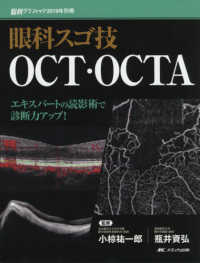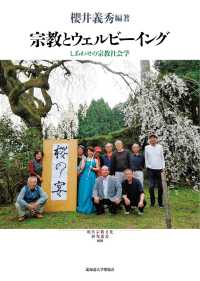- ホーム
- > 洋書
- > 英文書
- > Science / Mathematics
Full Description
Many food ingredients are supplied in powdered form, as reducing water content increases shelf life and aids ease of storage, handling and transport. Powder technology is therefore of great importance to the food industry. The Handbook of food powders explores a variety of processes that are involved in the production of food powders, the further processing of these powders and their functional properties.
Part one introduces processing and handling technologies for food powders and includes chapters on spray, freeze and drum drying, powder mixing in the production of food powders and safety issues around food powder production processes. Part two focusses on powder properties including surface composition, rehydration and techniques to analyse the particle size of food powders. Finally, part three highlights speciality food powders and includes chapters on dairy powders, fruit and vegetable powders and coating foods with powders.
The Handbook of food powders is a standard reference for professionals in the food powder production and handling industries, development and quality control professionals in the food industry using powders in foods, and researchers, scientists and academics interested in the field.
Contents
Contributor contact details
Woodhead Publishing Series in Electronic and Optical Materials
Preface
Chapter 1: Introduction to food powders
Abstract :
1.1 Introduction
1.2 Crystalline and amorphous microstructure of powders
1.3 Cohesive forces in powders
1.4 Adhesive forces and surface energetics
1.5 Stickiness of powders during their formation and handling
1.6 Surface structure of powders
1.7 Packing property of powders
1.8 Fluidity of powders
1.9 Compressibility of powders
1.10 Mixing property of powders
1.11 Segregation of powder particles
1.12 Dust formation and explosion risk
1.13 Hydration property of powders
1.14 Conclusion
Part I: Processing and handling of technologies
Chapter 2: Spray drying for food powder production
Abstract:
2.1 Introduction
2.2 Principles of spray drying
2.3 Spray drying techniques and configurations
2.4 Applications of spray drying in the production of food powder
2.5 Conclusion and future trends
2.6 Sources of further information and advice
Chapter 3: Freeze drying for food powder production
Abstract:
3.1 Introduction
3.2 The freeze drying process
3.3 Comparison to other drying methods
3.4 Freeze drying and powder production
3.5 Applications of freeze drying in the production of food powders
3.6 Conclusions and future trends
Chapter 4: Roller and drum drying for food powder production
Abstract :
4.1 Introduction
4.2 Principles and operation of drum dryers
4.3 Modelling and simulation of drum drying
4.4 Drum drying technology
4.5 Conclusion
4.6 Sources of further information and advice
Chapter 5: Modelling crystallization in spray drying for food powder production
Abstract:
5.1 Introduction
5.2 The spray-drying process
5.3 Principles of crystallization: Williams-Landel-Ferry (WLF) equation and explaining solid-phase crystallization during spray-drying process
5.4 Techniques and applications: comparing the relative degree of crystallinity of spray-dried powders using mathematical model
5.5 Limitations of the solid-phase crystallization model
5.6 Conclusions and future trends
Chapter 6: Grinding for food powder production
Abstract:
6.1 Introduction
6.2 Principles of grinding and modelling
6.3 Grinding technologies and equipments
6.4 Applications of grinding in the production of food powders
6.5 Limitations
6.6 Alternation drying and grinding (ADG) in powder technology
6.7 Conclusion and future trends
6.9 Appendix: nomenclature
Chapter 7: Agglomeration/granulation in food powder production
Abstract:
7.1 Introduction
7.2 Powder characteristics
7.3 Physicochemical reactivity of food powders
7.4 Agglomeration processes and mechanisms
7.5 Wet controlled growth agglomeration technologies
7.6 Wet agglomeration mechanisms and powder reactivity
7.7 Conclusion
Chapter 8: Fluidization in food powder production
Abstract:
8.1 Introduction
8.2 Principles of fluidization
8.3 Techniques and equipment
8.4 Applications of fluidization in the production of food powders
8.5 Limitations
8.6 Conclusion and future trends
8.7 Sources of further information and advice
8.9 Appendix: nomenclature
Chapter 9: Powder mixing in the production of food powders
Abstract:
9.1 Introduction
9.2 Mixture quality: defining and assessing
9.3 Mixing processes and mechanisms
9.4 Mixing devices
9.5 Some elements for powder-mixer calculation and scale-up
9.6 Conclusion and future trends
Chapter 10: Handling of food powders: flow patterns and storage design
Abstract:
10.1 Introduction
10.2 Basic flow patterns in storage vessels
10.3 Storage vessel design
10.4 Mass-flow operation
10.5 The Jenike silo design method
10.6 The flow-no flow criterion
10.7 Silo design worked example
10.8 Conclusion
10.10 Appendices
10.10.2 Appendix B: indicative bulk characteristics for a limited range of food powders
10.10.3 Appendix C: nomenclature
Chapter 11: Ensuring process safety in food powder production: the risk of dust explosion
Abstract:
11.1 Introduction
11.2 Dust explosion hazards
11.3 Laboratory testing to assess explosion characteristics of dust clouds
11.4 Safety from dust cloud explosion hazards
11.5 Specific unit operations
11.6 Conclusion
11.7 Sources of further information and advice
Part II: Powder properties
Chapter 12: Powder properties in food production systems
Abstract:
12.1 Introduction
12.2 Sampling, moisture content and chemical composition
12.3 Particle properties
12.4 Bulk properties of powders
12.5 Conclusion
12.6 Future trends
Chapter 13: Techniques to analyse particle size of food powders
Abstract:
13.1 Introduction
13.2 The importance of particle size of food powders
13.3 Collecting data for particle size analysis
13.4 Presenting particle size analysis data
13.5 Powder sampling and techniques for particle size analysis
13.6 Particle size analysis by direct methods
13.7 Particle size analysis by classification methods
13.8 Particle size analysis by secondary methods
13.9 Continuous and in-line measurements
13.10 Conclusion
Chapter 14: Surface composition of food powders
Abstract:
14.1 Introduction
14.2 Microscopy techniques for analyzing the surface of food powders
14.3 Spectroscopy techniques for analyzing the surface of food powders
14.4 Surface sorption and extraction techniques for analyzing the surface of food powders
14.5 Factors affecting food powder surface composition
14.6 Impact of powder surface composition on powder functionality
14.7 Food industry examples
14.8 Conclusion
14.9 Future trends
14.11 Appendix: abbreviations
Chapter 15: Food powder rehydration
Abstract:
15.1 Introduction
15.2 Principles of powder rehydration: wettability and sinkability
15.3 Principles of powder rehydration: dispersibility
15.4 Principles of powder rehydration: solubility
15.5 Improving powder rehydration properties
15.6 Conclusion
Chapter 16: Shelf-life of food powders
Abstract:
16.1 Introduction
16.2 Water absorption and desorption of food powders
16.3 Crystallization of amorphous powder
16.4 Oxidative changes
16.5 Effect of Maillard reactions on food products
16.6 Survival of dried probiotic bacteria
16.7 Conclusion
16.8 Sources of further information and advice
16.9 Acknowledgements
Part III: Speciality food powders
Chapter 17: Dairy powders
Abstract:
17.1 Introduction
17.2 Bulk production of dairy powders
17.3 Physical properties and qualities of dairy powders
17.4 Physicochemical properties and qualities of dairy powders
17.5 Applications of dairy powders
17.6 Factors affecting the properties of milk, whey and derivative powders
17.7 Control and improvement of powder properties
17.8 Conclusion
Chapter 18: Infant formula powders
Abstract:
18.1 Introduction
18.2 Global infant formula market
18.3 Nutritional composition
18.4 Classification of infant formula
18.5 Production of powdered infant formula
18.6 Conclusion
18.7 Future trends
Chapter 19: Powdered egg
Abstract:
19.1 Introduction
19.2 Production of egg powders: types and process
19.3 Drying technologies for egg powder production
19.4 Factors affecting the functionality of egg powders
19.5 Applications in the food and beverage industries
19.6 Conclusion
Chapter 20: Tea and coffee powders
Abstract:
20.1 Introduction
20.2 Factors affecting quality of instant coffee powder
20.3 Instant coffee production
20.4 Health effects of instant coffee powder
20.5 Instant tea powder production
20.6 Health effects of instant tea powder
20.7 Typical tea powder products
20.8 Conclusion
Chapter 21: Fruit and vegetable powders
Abstract:
21.1 Introduction
21.2 Fruit/vegetable powders and related products
21.3 Technologies for fruit and vegetable powder production
21.4 Grinding or pulverization
21.5 Storage
21.6 Conclusion
Chapter 22: Rice flour and related products
Abstract:
22.1 Introduction
22.2 Rice flour processing
22.3 Chemical composition and nutritional properties of rice flour
22.4 Physicochemical properties of rice flour
22.5 Modifications of rice flour
22.6 Conclusion
Chapter 23: Culinary powders and speciality products
Abstract:
23.1 Introduction
23.2 Herbs and spices
23.3 Soup powders
23.4 Salts
23.5 Safety of culinary powders
23.6 Conclusion
Chapter 24: Powders containing microorganisms and enzymes
Abstract:
24.1 Introduction
24.2 Drying of bacterial cultures
24.3 Preservation of yeasts and enzymes
24.4 Spray drying of lactic acid bacteria
24.5 Single droplet drying
24.6 Mechanisms of bacterial death and survival in the drying process
24.7 Bacterial survival during storage
24.8 Modelling of drying and survival kinetics
24.10 Future trends
24.11 Sources of further information and advice
Chapter 25: Coating foods with powders
Abstract:
25.1 Introduction
25.2 Types of powders used as food coatings
25.3 Principles and equipment for coating foods with powders
25.4 Difficulties caused by powder coating and ways to resolve them
25.5 Conclusion
25.6 Sources of further information and advice
Index






